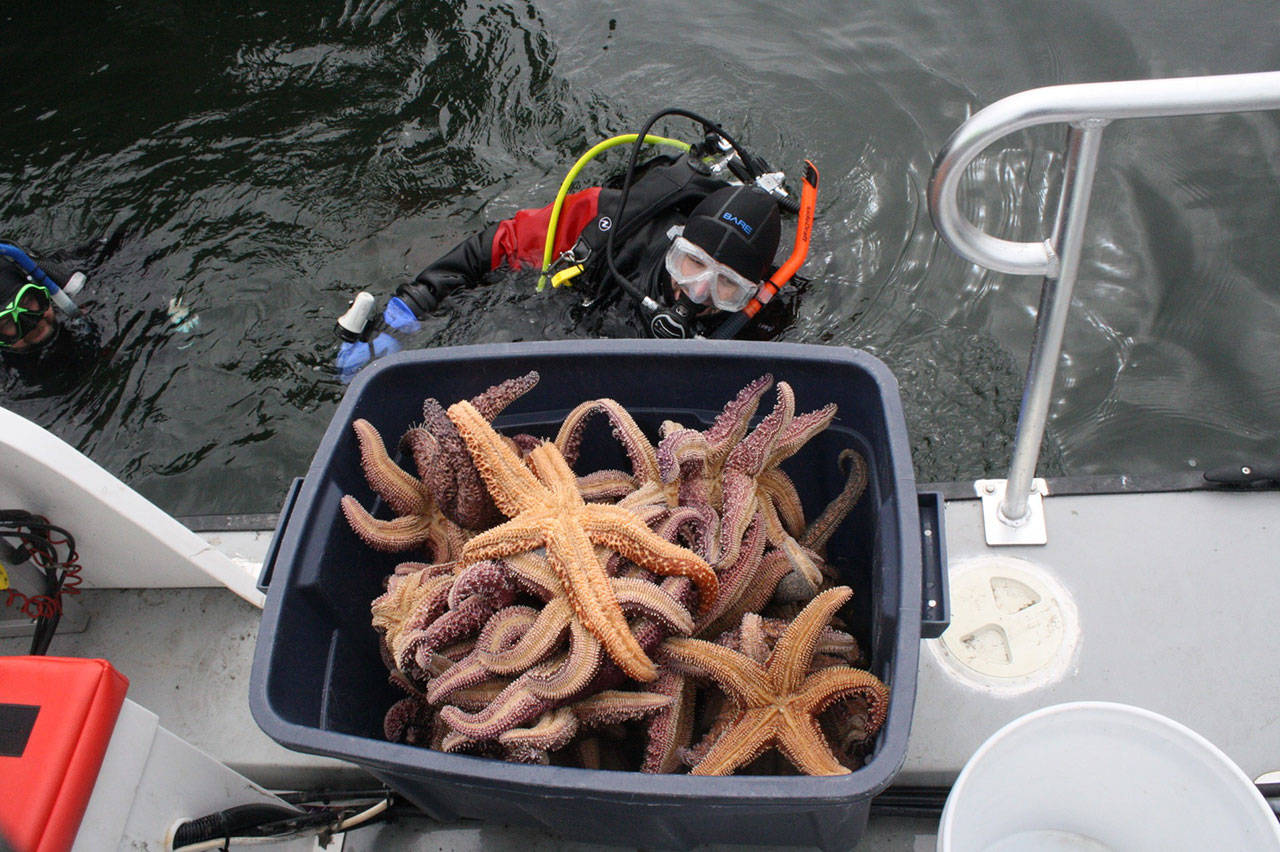A gaggle of marine aficionados have rescued a multitude of marine life from the soon-to-be-replaced Bainbridge city dock.
The underwater mission wrapped up late last week. A spewing of bubbles heralded the return of a diver to the surface beside the dock at Waterfront Park. And beside him, standing on the dock, was a group of volunteers carefully examining the biological treasure trove that had been pulled from the murky waters below.
Tube worms, tunicates, kelp crabs, anemones and more sea stars than Poseidon could shake a trident at were all pried from the dock’s stilts in a joint rescue effort between the Bainbridge Beach Naturalists, Exotic Aquatics, Bainbridge Island Rowing, Washington State Ferries, the Washington Department of Fish and Wildlife, the Bainbridge Island Land Trust and the city of Bainbridge Island.
City Manager Doug Schulze was on the docks as divers worked diligently below. Schulze said the group’s goal was to preserve the marine life attached to the pilings before construction to replace the dock threatens it.
“Certainly with the sea stars and the wasting disease that they’re going through, if we have an opportunity to save any we want to do that,” he said.
“With the construction that is going to happen here – pilings pulling out first – there’s a great chance that that marine life would not survive, so anything we can do to relocate it and help the harbor and the Sound is something we want to do,” he said.
Also on the docks was Rich Seubert, one of the few remaining Eagle Harbor liveaboards and a close friend of the late, famed octopus hunter Jack Welfare.
Seubert said the event was something he thought Welfare would have appreciated.
“We did a lot of diving; he was very familiar with all the different critters that were on the bottom of the seafloor, in fact one time I remember we took a class out to Blakely Rock and he dove down and brought up sea urchins and sea stars and explained what all the different animals were,” Seubert said.“ Jack was very much attuned with the water.”
Gunnar Lockett was one of the younger volunteers on the docks last Thursday, but what he lacked in years he made up for in his knowledge of marine invertebrates.
Gunnar peered over one of the white buckets and pulled from it a seaweed-colored crab with long, spindly legs.
“You can see the little spikes, that’s kind of what identifies it,” Gunnar said, holding up the kelp crab caught by the divers. “He’s a little bit like a monkey crab, or a spider crab as you would say. You can kinda tell because he’s red on the bottom.
“Some people eat them, but most people eat Dungeness,” Gunnar added.
When asked if he would consider eating his kelp crab, Gunnar wasn’t the least bit sentimental.
“I’d eat his pinchers; there’s lots of meat right there,” he said.
Beside Gunnar was Maradel Gale, the program director for the Bainbridge Beach Naturalists. Gale said that the group had been keeping a keen eye on the island’s sea star population following recent large-scale die-offs of sea star populations along the West Coast.
“We’ve been monitoring on the island a couple of sites to see if the sea stars are recovering and there are a few here, but we are delighted to see how many we’ve been able to rescue today,” Gale said.
By her count, Gale’s team recovered 58 sea stars, 56 of which were ochre sea stars (Pisaster Ochraceus) and two mottled sea stars (Evasterias Troscheli).
Additionally, the divers relocated some 15 kelp crabs, two red rock crabs, four graceful rock crabs, seven burrowing sea cucumbers and other various anemones, chitins, nudibranchs and green sea urchins.
Gale also noted that the divers would have probably been able to find more juvenile sea stars if visibility below the surface had been better.
“They’re down there and it’s very murky and they’re using lights as it is, the juveniles can hide out among the mussels and things, so it’s hard to find them,” she said. “It’s not good visibility here, there’s so much stuff in the water, a lot of diatoms in the water, that makes it very hard to see.”
Gale also detailed the process by which divers were relocating the animals.
“The Washington State Ferry maintenance yard gave us permission to relocate the animals there; the divers are taking them down and putting them at the bottom of the pilings and the animals will crawl up the pilings and re-establish themselves there,” Gale said. “If they were here come the fifth of September, they’d be in the dump,”
Over by the Trask Pier, John Foy stood at the helm of one of the Bainbridge Island Rowing club’s launch boats. On the deck of the boat sat a Rubbermaid tub brimming with sea stars collected from the city dock. In the water beside Foy’s boat were three frog-lipped divers clad in black neoprene hoods: Justin Wolf, Mo Gibson and Austin Voecks prepared to move the starfish to their new home.
As Foy passed the bin down to the divers, it floated for a moment on the surface of the water. One diver tipped the bin of star fish over filling it with water. As the bin filled, it and the divers all quickly sank out of sight with only the occasional burst of bubbles to indicate their presence below.



